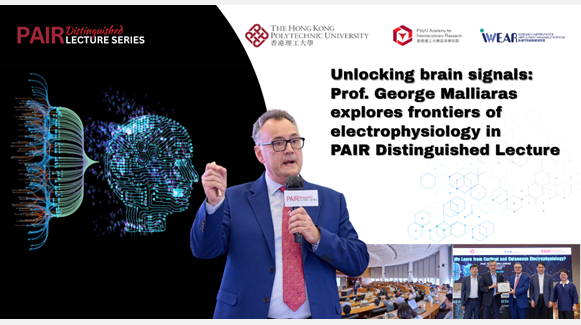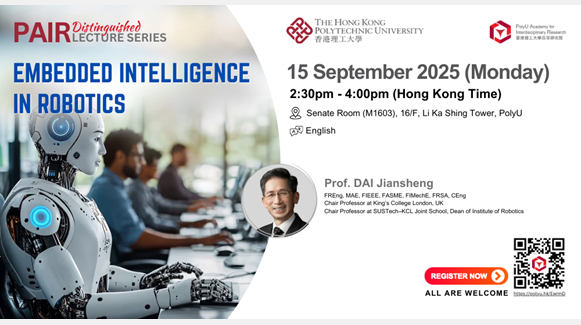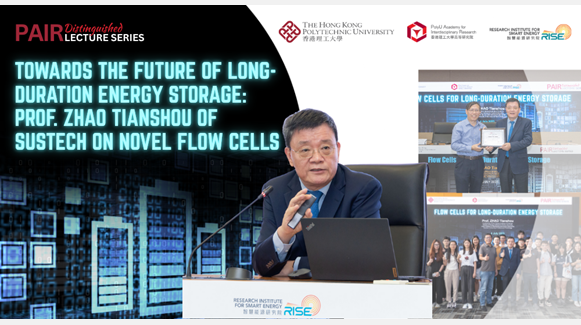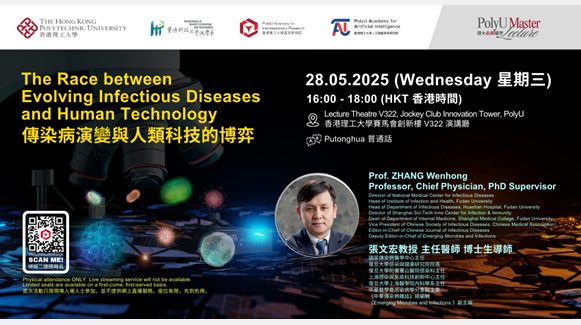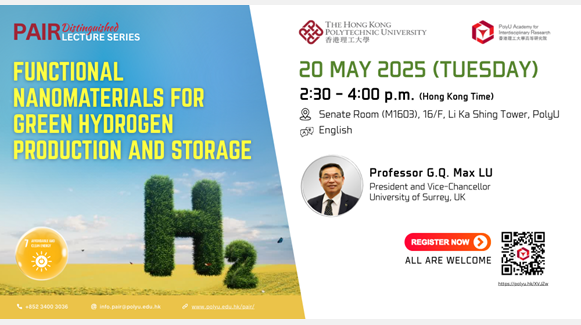PAIR Seminar by Prof. Iain McCulloch on ‘Harnessing the Sun for Chemistry’
PAIR Seminar Series

-
Date
02 Oct 2025
-
Organiser
PolyU Academy for Interdisciplinary Research
-
Time
14:30 - 16:00
-
Venue
Senate Room, M1603, 16/F Li Ka Shing Tower, PolyU (Limited seats are available on a first-come, first-served basis)
Speaker
Prof. Iain McCULLOCH
Enquiry
PolyU Academy for Interdisciplinary Research info.pair@polyu.edu.hk
Summary
Green hydrogen, produced from water using renewable energy, is anticipated to become a leading fuel of the future, offering clean, carbon-free energy for a wide range of industrial applications. It also has the potential to provide complementary energy storage when combined with intermittent solar power. However, achieving economically competitive, large-scale solar-generated hydrogen production remains a significant challenge. Photochemical water splitting, a process that uses light-absorbing nanoparticle semiconductors to drive redox reactions on their surface, offers a promising solution.
At the PAIR Seminar on 2 October 2025, Prof. Iain McCULLOCH of Princeton University, USA, shared the latest developments in photochemical water splitting. His talk, titled “Harnessing the Sun for Chemistry”, focused on the use of light-absorbing nanoparticle semiconductors capable of driving redox reactions on their surface. The seminar attracted over 80 in-person participants and an online audience of more than 15,500 across various social media platforms.
To begin his presentation, Prof. McCulloch briefly introduced the development of photo-catalysts fabricated from organic semiconductors, which can be chemically tuned to absorb strongly throughout the UV-visible spectrum. His research has demonstrated that these organic semiconductor nanoparticles, featuring an internal donor/acceptor heterojunction between two organic semiconductors with a type II energy level offset, achieve higher solar-to-hydrogen efficiency than traditional inorganic photocatalysts. The donor/acceptor heterojunction significantly enhances charge generation within the nanoparticles, thereby greatly improving their hydrogen production efficiency. Furthermore, his team has also shown that adjusting the nanoparticle composition can substantially increase hydrogen production efficiency.
Prof. McCulloch’s research team also observed that the high efficiency of these nanoparticles stems from their ability to generate exceptionally long-lived reactive charges upon illumination, increasing their likelihood of participation in photocatalytic reactions. In addition, he discussed solution-processable, linear conjugated polymers of intrinsic porosity for gas-phase carbon dioxide photoreduction, highlighting the potential of such polymers in transforming carbon dioxide into solar fuels.
Following the presentation was a lively question-and-answer session moderated by Prof. YAN Feng, Associate Director of Research Institute for Intelligent Wearable Systems (RI-IWEAR) and Chair Professor of Organic Electronics. The audience engaged in a productive discussion with Prof. McCulloch.
Please click here for an online review.
Photo Gallery
Prof. Iain McCULLOCH of Princeton highlights next-generation solar fuels at PAIR Seminar





Prof. Iain McCULLOCH
Fellow of the Royal Society
Gerhard R. Andlinger '52 Professor in Energy and the Environment
Director of the Andlinger Center for Energy and the Environment
Professor in the Department of Electrical and Computer Engineering
Princeton University, USA
Prof. Iain McCulloch is the Director of the Andlinger Center for Energy and the Environment and a Professor of Electrical and Computer Engineering at Princeton University, as well as holding a Visiting Professor position in the Department of Chemistry at the University of Oxford. He previously held joint appointments as Professor of Chemical Science and Director of KAUST Solar Center at KAUST, as well as a Chair in Polymer Materials in the Chemistry Department at Imperial College. Before joining academia, he spent 18 years managing industrial research groups at Hoechst in the US and Merck in the UK. He is a Fellow of the Royal Society, the Royal Society of Chemistry, the European Academy of Sciences and a Member of Academia Europaea. He is the recipient of the 2022 Royal Society Armourers and Brasiers Prize, the 2020 Blaise Pascal Medal for Materials Science, the Royal Society of Chemistry 2020 Interdisciplinary Prize, 2014 Tilden Medal for Advances in Chemistry and the 2009 Creativity in Industry Prize. His interests are in the design and investigation of organic semiconducting materials.
You may also like




